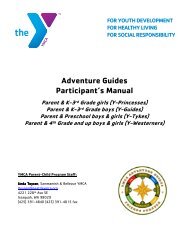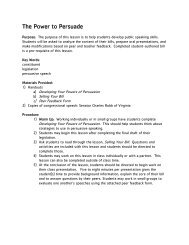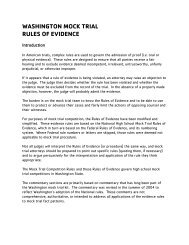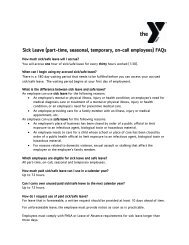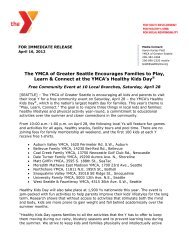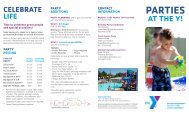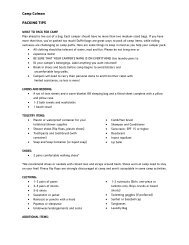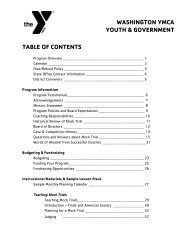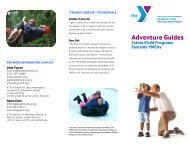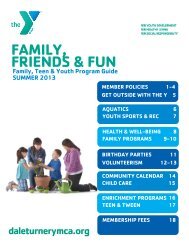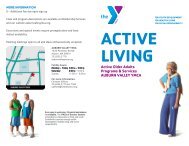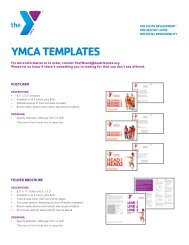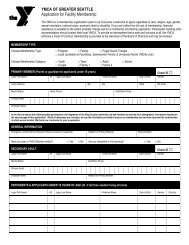Swim Lesson Brochure.pub - YMCA of Greater Seattle
Swim Lesson Brochure.pub - YMCA of Greater Seattle
Swim Lesson Brochure.pub - YMCA of Greater Seattle
Create successful ePaper yourself
Turn your PDF publications into a flip-book with our unique Google optimized e-Paper software.
BUILDING<br />
CONFIDENCE<br />
<strong>Swim</strong> <strong>Lesson</strong>s<br />
The Meredith Mathews East Madison <strong>YMCA</strong> Aquatics <strong>Swim</strong> <strong>Lesson</strong> program is student centered and includes five main learning components:<br />
Stroke development, water sports, personal safety, rescue and personal growth. Class levels are based on age and ability <strong>of</strong> the<br />
participant.<br />
<strong>Swim</strong> <strong>Lesson</strong>s at the MMEM <strong>YMCA</strong> develop competency in swimming, along with confidence and endurance. A child is advanced to the<br />
next level only when he or she can pr<strong>of</strong>iciently and safely perform the skills within his or her level.<br />
All children learn and progress at his or her own rate. If your child does not complete all the skills within his or her level during any one<br />
session they will continue in the same level until they are able to master the skills. Graduation from a swimming level requires permission<br />
from an instructor. Grades are posted on the Wall Roster (located on the wall just outside the pool side <strong>of</strong> the woman’s locker room) the<br />
week before priority registration.<br />
SWIM LESSON SKILLS BY LEVEL<br />
These lists do not include all the skills covered in each level; it contains those skills that<br />
may help parents determine the level at which their child should register. Look at each<br />
level and determine whether your child can consistently perform all the skills within that<br />
level. If so, check the next level, and keep moving through until you reach one for which<br />
your child cannot consistently perform all the skills. That probably is the right level for<br />
your child. It is better to underestimate the child’s abilities than to overestimate the child’s<br />
abilities. It is easier to move a child to a higher level than to move him or her down. If you<br />
are still not sure <strong>of</strong> your child’s level after looking at this list, contact the Aquatic Depart-<br />
PARENT-CHILD SWIM LEVELS<br />
Ages 6 month-3 years<br />
The primary objective is to get both the parent and child comfortable in the water.<br />
The child will become aware <strong>of</strong> the differences between moving through water<br />
and on dry land, while the parent will become aware <strong>of</strong> how to teach his or her<br />
child to be safer in and around the water. Classes are designed to allow the child<br />
to have fun in the water while the parent guides him or her to learn aquatic skills.<br />
The child will be exposed to games that use basic movements in the water, such<br />
as kicking, arm strokes, and breath control. Activities are based on the developmental<br />
abilities <strong>of</strong> the child.<br />
WATER BABIES Ages 6-36 months<br />
• Water acclimation: Has a happy expression in the water, wets face and arms<br />
and imitates parents by putting face in the water<br />
• Water entry/exit: Enters the pool—from a sitting position upon request,<br />
climbs out <strong>of</strong> the pool with assistance<br />
• Breath control: Shipping and expelling water on cue, submerging and blows<br />
bubbles on request or cue<br />
• Balance: Maintains stable vertical position in an IFD without parental support,<br />
balances on parent’s knee with minimal support, navigates, turns 180<br />
to 360 degrees while wearing a PFD<br />
• Locomotion: Alternating paddles and kicks
PARENT-CHILD SWIM LEVELS<br />
Ages 6 month-3 years<br />
• Water entry/exit: Baby wait, 5-10 seconds, independent<br />
water entry/exit, sitting glides, jump in and swim back to the<br />
wall<br />
• Safety: Use <strong>of</strong> PFDs and IFDs (lifejacket and float belt), swim<br />
with another adult other than mom or dad, walks on the pool<br />
deck to a target location (stairs)<br />
• Breath Control: Submerging and immersing face, breath<br />
control and inhales then blows bubble independently, front<br />
float 10 seconds, back float 10 seconds, rotary breathing<br />
on the wall (bobs)<br />
• Locomotion: <strong>Swim</strong>, get a bit <strong>of</strong> air and swim again, reach and<br />
pull alternating arms, independent flutter kick<br />
PRESCHOOL SWIM LEVELS Ages 3-5<br />
This program <strong>of</strong>fers children their first experience in the pool<br />
without parental assistance. Children are taught the basic skills<br />
that are the building blocks <strong>of</strong> swimming while learning about pool<br />
safety, boating safety, and the use <strong>of</strong> personal flotation devices.<br />
A caring, certified swim instructor teaches the 30-minute class.<br />
Class participants are divided into skill levels, and class size is<br />
such that the instructor can provide children with individual attention.<br />
PIKES Ages 3-5<br />
• Willingly put face in the water when asked<br />
• 5 bobs with bubbles, getting a breath each time<br />
• Release from the wall, swim/paddle away, turn, paddle back<br />
• Front float 10 seconds (face in the water), take a breath, and<br />
recover<br />
• Back float 10 seconds, recover.<br />
• Wearing an IFD paddle stroke 5 yards front and kick on back<br />
5 yards<br />
• Gain self-confidence<br />
• <strong>Swim</strong> 5ft <strong>of</strong> each without an IFD: Paddle on front, back and<br />
side<br />
EELS Ages 3-5<br />
• Push <strong>of</strong>f the wall, swim/paddle 5ft away, turn, and grab the<br />
wall<br />
• Front float 20 seconds (face in the water), take a breath, and<br />
recover<br />
• Back float 20 seconds, recover.<br />
• Jump in with IFD, paddle on front 10 yards, turn, kick on back<br />
10 yards<br />
• <strong>Swim</strong> 15ft without an IFD: <strong>Swim</strong> on front with face in arms<br />
reaching out and rhythmic breathing, swim on back with horizontal<br />
position, swim on side with alternating arms.<br />
RAYS Ages 3-5<br />
• Front and back float 30 seconds without an IFD<br />
• Tread water 30 seconds with an IFD<br />
• Jump in deep end, swim 5 feet, back float 10 seconds<br />
and return<br />
• Bob 10 times in shallow water, getting a breath each<br />
time<br />
• Jump into deep water, swim up 5-7 feet<br />
• Sitting and kneeling dives<br />
• <strong>Swim</strong> 20ft without an IFD: Front crawl with rotary<br />
breathing, basic breaststroke with rhythmic breathing,<br />
side alternating stroke, backstroke with straight arms,<br />
basic elementary backstroke with glide<br />
STARFISH Ages 3-5<br />
• Head-first surface dive, recover<br />
• Front and back float 1 minute<br />
• Tread water 30 seconds without an IFD<br />
• Jump into deep water, swim 15 feet, back float 10 seconds,<br />
and return<br />
• Bob 10 times on deep water, getting a breath each time<br />
• <strong>Swim</strong> 40 feet without a float belt: Crawl stroke with side<br />
breathing, breaststroke with glide, symmetrical whip kick and<br />
rhythmic breathing, sidestroke with scissor kick, backstroke<br />
with straight arms and horizontal position, elementary backstroke<br />
with glide and symmetrical whip kick, introduction to<br />
butterfly with dolphin kick (20 feet)<br />
YOUTH SWIM LEVELS Ages 6-12<br />
This program comprises five main components: personal growth,<br />
personal safety, stroke development, water sports and games, and<br />
rescue. Each skill level builds upon the preceding level, with six<br />
levels covering all the strokes, diving fundamentals, and safety<br />
skills.<br />
POLLIWOG Ages 6-12<br />
• Walk or swim away from the pool wall, turn around, reach and<br />
grab the wall<br />
• Front and back float 30 seconds without and IFD, recover/stand<br />
• Jump in and return to the side without assistance<br />
• Jump in deep water with an IFD swim 10 yards on front, kick on<br />
back 10 yards<br />
• Gain Self-Confidence<br />
• Paddle for 20ft without an IFD: Front paddle with face in water,<br />
back paddle with horizontal body position, side paddle with ear<br />
in the water<br />
GUPPY Ages 6-12<br />
• Front and back float 1 minute without IFD, recover/stand<br />
• Tread water 30 seconds without an IFD<br />
• Jump into deep water, swim up 5-7 feet, paddle 15ft, back<br />
float 10 seconds, and return with out IFD<br />
• Perform 10 bobs in deep water, getting a breath each time<br />
• Kneeling dive with assistance, glide/swim 15 feet<br />
• <strong>Swim</strong> for 25 yards without an IFD: Front crawl and rotary<br />
breathing, basic breaststroke with rhythmic breathing, side<br />
alternating stroke, back crawl with straight arms, basic elementary<br />
backstroke
GUPPY Ages 6-12<br />
• Front and back float 1 minute without IFD, recover/stand<br />
• Tread water 30 seconds without an IFD<br />
• Jump into deep water, swim up 5-7 feet, paddle 15ft, back<br />
float 10 seconds, and return with out IFD<br />
• Perform 10 bobs in deep water, getting a breath each time<br />
• Kneeling dive with assistance, glide/swim 15 feet<br />
• <strong>Swim</strong> for 25 yards without an IFD: Front crawl and rotary<br />
breathing, basic breaststroke with rhythmic breathing, side<br />
alternating stroke, back crawl with straight arms, basic elementary<br />
backstroke<br />
MINNOW Ages 6-12<br />
• Tread water 1 minute with and effective kick/Circle Kick for 1<br />
minute<br />
• Bob 10 times in deep water, getting a breath each time<br />
• Kneeling dive <strong>of</strong>f deck<br />
• <strong>Swim</strong> 25 yards without and IFD (all with GOOD form): Front<br />
crawl with side breathing and arms glide front, breaststroke<br />
with rhythmic breathing, glide and symmetrical whip kick, basic<br />
sidestroke with scissor kick, back crawl with opposite<br />
straight arms, elementary backstroke with glide and symmetrical<br />
whip kick<br />
FISH Ages -12<br />
• Float 6 minutes with minimum movement front or back<br />
• Tread water 3 minutes using a combination <strong>of</strong> kicks<br />
• Scull head-first and feet-first, 45 feet each<br />
• Head-first and feet-first surface dive own 6-8ft<br />
• <strong>Swim</strong> 50 yards: Crawl stroke with side breathing and open<br />
turns, breaststroke with pull-breath-kick-glide rhythm and<br />
open turns, elementary backstroke with glide, backstroke<br />
with: body roll, bent arm pull and open turns, sidestroke with<br />
scissor kick and glide, basic butterfly (15 yards only)<br />
FLYING FISH Ages 6-12<br />
• Tread water 6 minutes using all four kicks: single, double,<br />
circle, and rotary<br />
• <strong>Swim</strong> under water 3-4 body lengths with modified breaststroke<br />
• Freestyle flip turn for crawl and back stroke<br />
• Kneeling dives with streamline (focus on distance and body<br />
position)<br />
• <strong>Swim</strong> 100 yards (focus on efficiency): Crawl stroke with bilateral<br />
breathing and flip turns, elementary backstroke with<br />
flexed hips and glide, backstroke with: body roll, bent arm<br />
pull and flip turns, sidestroke (alternate sided) with scissor<br />
kick, lifesaving stroke (50 yards), butterfly (25 yards)<br />
SHARK Ages 6-12<br />
• Take your own heart rate and swim within target heart rate<br />
range<br />
• <strong>Swim</strong> 200 yards individual medley (fly, back, breast, crawl)<br />
with proper turns<br />
• Start dives with step up, take your mark, and go!<br />
• <strong>Swim</strong> 100 yards (focus on endurance and pace): Crawl stroke<br />
with streamline, body roll, and flip turns, breaststroke with<br />
pull-out and glide, inverted breaststroke (50 yards), backstroke<br />
with dolphin kick/streamline and flip turns, over arm<br />
sidestroke, alternate sides (50 yards), butterfly with push-<strong>of</strong>f<br />
and streamline (50 yards)<br />
BEGINNER ADULT Ages 13+<br />
• Front Float and Back Float 1 minute without an IFD<br />
• Tread water 30 seconds without an IFD<br />
• <strong>Swim</strong> 50 yards: Front Crawl & rotary breathing, back Crawl<br />
with straight arms<br />
• <strong>Swim</strong> 25 yards: Basic Breaststroke with rhythmic breathing<br />
and glide, basic Elementary Backstroke with glide<br />
INTERMEDIATE ADULT Ages 13+<br />
• Front float and Back Float for 1 minute with minimal movement<br />
• Tread water 2 minutes using an effective kick<br />
• Proper open turns<br />
• <strong>Swim</strong> 100 yards: Crawl stroke with side breathing, breaststroke<br />
with Pull-Breath-Kick-Glide rhythm, elementary backstroke<br />
with glide, backstroke with body roll & bent arm pull<br />
• <strong>Swim</strong> 25 yards: Sidestroke with scissor kick<br />
• <strong>Swim</strong> 15 yards: Butterfly (25 yards with flippers)<br />
ADVANCED ADULT/SWIM CLINIC Ages 13+<br />
• Take your own heart rate and swim within target heart rate<br />
range<br />
• <strong>Swim</strong> 200 yards (focus on endurance and pace): Crawl stroke<br />
with streamline, body roll, and flip turns, breaststroke with<br />
pull-out and glide, elementary Backstroke with flexed hips<br />
and glide, backstroke with dolphin kick/streamline and flip<br />
turns<br />
• <strong>Swim</strong> 50 yards: Sidestroke with scissor kick and glide, butterfly<br />
with push <strong>of</strong>f wall and streamline<br />
• <strong>Swim</strong> 200 yards: Individual medley (fly, back, breast, crawl)<br />
PRIVATE AND SEMI-PRIVATE LESSONS<br />
MMEM <strong>YMCA</strong> <strong>of</strong>fers one-on-one private lessons. Our Private <strong>Swim</strong><br />
<strong>Lesson</strong> program is designed to allow members, not appropriate for<br />
group lessons, the opportunity to participate in a safe, fun one on<br />
one setting. Each student is paired with an instructor based on<br />
needs and abilities.<br />
Instructors use positive reinforcement and a fun learning environment<br />
to help every child and adult feel successful in an aquatic<br />
environment.<br />
Complete a private lesson request form and an Aquatics Staff<br />
member will contact you when space becomes available.<br />
Facility Members: $30 per ½ hour<br />
Program Members: $50 per ½ hour<br />
For more information contact Kevin Riordan at<br />
kriordan@seattleymca.org<br />
ADAPTIVE AQUATICS<br />
Adaptive Aquatics (AA) is a great opportunity for youth and adults<br />
with developmental, physical, medical, or social special needs to<br />
learn to swim in a safe and supportive environment.<br />
Participants in this program should have a referral from a doctor,<br />
therapy provider, or approval from Aquatics Management staff.<br />
Private (AA) <strong>Lesson</strong>s (FM): $15 per ½ hour<br />
Private (AA) <strong>Lesson</strong>s (PM): $20 per ½ hour<br />
(Maximum: three participants )<br />
For eligibility information please contact<br />
Karine Zwicki at kzwicki@seattleymca.org
SUMMER SESSIONS 2011 July 5th—September 3rd<br />
Summer Session 1 (evenings/Sat) July 5th —August 6th<br />
Summer Session 2 (evenings/Sat) August 8th—September 3rd<br />
1 Week Intensive (M-Th mornings) July 11th—14<br />
July 8th—21<br />
July 25th—28th<br />
August 1st—4th<br />
August 8th—11th<br />
August 15th—18th<br />
August 22nd—25th<br />
August 29th—September 1st<br />
Refunds and Credits<br />
We cannot give refunds or makeup days for missed classes. However,<br />
if you need to withdraw from the remainder <strong>of</strong> the session<br />
because <strong>of</strong> injury or illness, contact the aquatics director so appropriate<br />
credit arrangements can be made.<br />
WHAT TO WEAR<br />
• Parent Child (Water Tots) : All children must wear tight fitting pants (preferably with a plastic cover). <strong>Swim</strong> diapers or training pants with<br />
rubber pants over them are possible options.<br />
• A <strong>Swim</strong> Suit is required for all persons.<br />
• Shirts and Tank tops are not allowed unless they are made <strong>of</strong> polyester, nylon or spandex and are not washed with fabric s<strong>of</strong>tener.<br />
• Jean and cotton clothing are prohibited.<br />
• Girls should wear a regulation swimsuit or a leotard that fits snugly. Boys should wear a swimsuit/swim trunks with lining.<br />
• Shoulder length hair should be put up in a pony tail or swim cap. Long bangs also need to be put up so they do not fall into the eyes or<br />
mouth.<br />
• Goggles, nose plugs, etc., are not recommended for children until they can demonstrate the proper skills without these items (Pike, Eel &<br />
Polliwog classes).<br />
• A swim diaper is required for anyone with continence issues. Bathers wearing diapers need to have tight fitting protective coverings. Be<br />
aware that swim diapers and protective swim pants are not a solution for a person with diarrhea or a substitute for frequent diaper<br />
changing.<br />
Six “P-L-E-As” for Protection Against Recreational Water Illnesses (RWIs)<br />
• PLEASE don’t swim when you have diarrhea. This is especially important for kids in diapers.<br />
• PLEASE don’t swallow the pool water.<br />
• PLEASE practice good hygiene.<br />
• PLEASE take your kids on bathroom breaks <strong>of</strong>ten.<br />
• PLEASE change diapers in a bathroom and not at poolside.<br />
• PLEASE wash your child thoroughly (especially the rear end) with soap and water before and after swimming.<br />
HEALTH INFORMATION<br />
Please Please Please keep keep keep your your your children children children home home home from from from swim swim swim lessons lessons lessons for: for:<br />
for:<br />
• Green mucus or yellow discharge from the nose.<br />
• Had a fever, vomited or diarrhea in last 2 weeks.<br />
• Headache, earache, sore throat, listlessness or loss <strong>of</strong><br />
appetite.<br />
• Had shots/immunizations that day.<br />
• Sinus or ear infections.<br />
MEREDITH MATHEWS EAST MADISON <strong>YMCA</strong><br />
1700 23rd Ave, <strong>Seattle</strong>, WA 98122<br />
P 206 322 6969 meredithmathewsymca.org<br />
REGISTRATION INFORMATION<br />
PRIORITY Registration<br />
For participants currently enrolled, registration generally begins for<br />
all sessions on the Friday, 1.5 1.5 weeks weeks before the start <strong>of</strong> a new session.<br />
OPEN registration<br />
For those not currently enrolled who wish to participate in swim<br />
lessons and generally begins the Monday 1-week before the beginning<br />
<strong>of</strong> the next session.<br />
For <strong>Swim</strong> <strong>Lesson</strong> Registration Information: Please see the MMEM<br />
<strong>YMCA</strong> website or talk with the Member Services Desk.<br />
FEES<br />
<strong>Swim</strong> lesson fees vary by class. Please see the Member Services Desk<br />
for pricing or online registration.<br />
Everyone is welcome. Financial assistance is available. The <strong>YMCA</strong> <strong>of</strong> <strong>Greater</strong><br />
<strong>Seattle</strong> strengthens communities in King and south Snohomish counties through youth<br />
development, healthy living and social responsibility.



